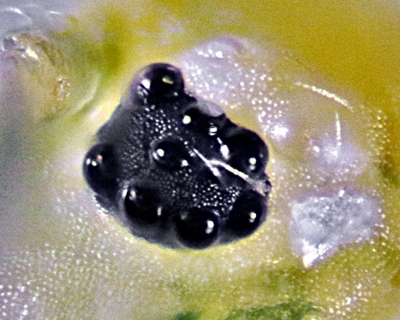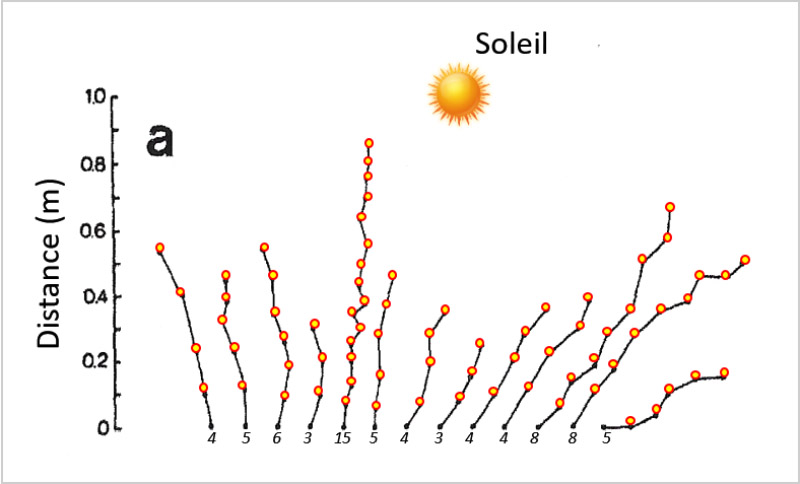 Springtails do not have compound eyes, as is the case with almost all insects. Their vision is made from a group of simple or ocellated eyes grouped in the ocular plates and whose number and disposition vary according to the species.
Springtails do not have compound eyes, as is the case with almost all insects. Their vision is made from a group of simple or ocellated eyes grouped in the ocular plates and whose number and disposition vary according to the species.
These characteristics relating to different species are valuable indicators in taxonomy. Note also the presence of bristles implanted on the ocular plates. The black and white illustrations are images made with a scanning electron microscope that allows very high magnifications revealing the specific distribution of ocelli.
Sometimes absent or reduced (species living under the earth), the ocelli are grouped on two symmetrical ocular areas which can each comprise a maximum of eight. In general, a distribution of 8 + 8 or 2 + 2 ocelles is observed. Given the low density of nerve cells present on the optic lobes, it can be inferred that the visual acuity of springtails is likely to be very limited. Note however that the size, shape and distribution of ocelli in different individuals suggests some selective pressure showing that these ocelli contribute to their level to the survival of springtails1.
Opposite, the eye plate of a Gomphiocephalus hodgsoni, a species found in Antarctica that is one of the rare species able to survive in such extreme climates. The diameter of each eye does not exceed 10 microns which represents the critical size of an eye to be able to produce an image. (One can wonder what could be the composite image produced from each of the ocelli).

Above left to right: Cluster of ocelli (magnification x 1500) on Hypogastrura nivicola2. Head of Sminthuries sp.3. There are 8 + 8 ocelli of which 2 + 2 are reduced. Concerning the vision of collembola, a study4 shows that during their migrations on snow-covered areas, which therefore have no reference point, certain species such as Hypogastrura socialis use their eyes to calculate the elevation angle of the Sun before making a jump. .
 This study also shows that they would be able to detect the polarization angle of light. The diagram I have taken above shows the orientation and the number of jumps made by a population tested of 13 individuals. The starting points of each jump listed are marked by the red / yellow dot. It is clear that the distribution of the series of jumps makes a movement around the Sun.
This study also shows that they would be able to detect the polarization angle of light. The diagram I have taken above shows the orientation and the number of jumps made by a population tested of 13 individuals. The starting points of each jump listed are marked by the red / yellow dot. It is clear that the distribution of the series of jumps makes a movement around the Sun.
These results are a perfect illustration of the behavior of springtails populations directly impacted by environmental conditions, relative to a sensory perception, in this case vision.
Some examples of implementation5:

Implantation of the ocular plates on Entomobryomorph (Orchesella).

Ocular implantation on Symphypleone (Sminthurides viridis).

Ocular implantation on Poduromorph (Monobella grassei).
1: Victor Benno, Meyer-Rochow, Walton Reid & Jozsef Gal. An ultrastructural study of the eye of Gomphiocephalus hodgsoni, a collembolan from Antarctica. Polar Biol (2005).
2: Jean-Raymond Bilodeau. Collembole nivicole or "snow flea". Bulletin of Entomofauna No. 20 (Oct 1998)
3: Image: Palacios-Vargas. J. Sminthurides sp. (2000) electron microscope.
4: Hagvar Sigmund. Long distance directional migration on snow - hypogastrura socialis. Acta zoologica fennica (1995).
5: Image early article and "implantation ocelles": Philippe Garcelon.